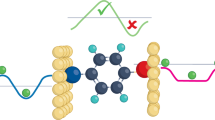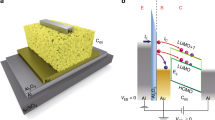Abstract
Owing to the saturation of the efficiency of silicon devices in electronics industry, molecular electronics has gained tremendous impetus in recent times. Theoretical predictions and experimental realizations of such systems have given birth to a new generation of miniaturized electronic devices. Organic molecules with delocalized π-electrons show a promising future in this aspect. The long-standing history and interesting properties of two isomeric organic molecules, naphthalene and azulene, motivate us to explore their electrical conductance property and possible electronic device applications that exploit the unique characteristics associated with their structural aspects. Single molecule of azulene shows higher conductivity than naphthalene. The charge transfer from the seven-membered ring to the five-membered ring in azulene gives the system aromatic stability, making it dipolar. As a consequence, the conductance becomes asymmetric for forward and reverse bias, opening an efficient application of azulene as molecular rectifier in electronic device fabrication.
Similar content being viewed by others
Suggested Reading
Supriyo Datta, Quantum Transport: Atom to Transistor, Cambridge University Press, Cambridge, UK, 2005.
M Galperin, M A Ratner and A Nitzan, J. Phys.: Condens. Matter, Vol. 19, p.103201, 2007.
M A Reed et al, Science, Vol.278, p.252, 1997.
M A Reed et al, Appl. Phys. Lett., Vol.78, p.3735, 2001.
S Lakshmi, S Dutta and S K Pati, J. Phys. Chem. C, Vol.112, p.14718.,2008.
S Lakshmi and S K Pati, Phys. Rev., Vol.B72, p.193410, 2005.
S Lakshmi and S K Pati, J. Chem. Phys., Vol.121, p.11998, 2004.
S Lakshmi, A Datta and S K Pati, Phys. Rev., Vol.B72, p.045131, 2005.
S Sengupta, S Lakshmi and S K Pati, J. Phys.: Condens. Matter, Vol.18, p.9189, 2006.
S Dutta, S Lakshmi and S K Pati, J. Phys.: Condens. Matter, Vol.19, p.322201, 2007.
S Dutta and S K Pati, J. Phys.: Condens. Matter, Vol.20, p.075226, 2008.
S Dutta, S Lakshmi and S K Pati, Bulletin of Material Science, Vol.31, p.353, 2008.
A Stirling, M Iannuzzi, A Laio and M Parrinello, Chem. Phys. Chem., Vol.5, p.1558, 2004.
A G Anderson and B M Steckler, J. Am. Chem. Soc., Vol.81, p.4941, 1959, and the references therein.
A Aviram and M A Ratner, Chem. Phys. Lett., Vol.29, p.277, 1974.
R M Metzger et al, J. Am. Chem. Soc., Vol.119, p.10455, 1997.
S -H Ke, W Yang and H U Baranger, Nano Lett., Vol.8, p.3257, 2008.
Supriyo Datta, Electronic Transport in Mesoscopic Systems, Cambridge University Press, Cambridge, UK 1995.
Gaussian 03, Revision Vol.B.05, M J Frisch, Gaussian, Inc., Pittsburgh PA, 2003.
Author information
Authors and Affiliations
Corresponding author
Additional information
(left) Sudipta Dutta is currently pursuing doctoral research in JNCASR, Bangalore. His research interests include quantum many-body theory, ab initio quantum chemistry, electronic structure theory, molecular electronics and hydrogen storage.
(right) Swapan K Pati is an associate professor at JNCASR, Bangalore. His research interests include quantum many-body theory, molecular electronics, non-linear optical phenomena, quantum magnetism, generalized charge-transfer mechanisms and hydrogen storage. He is also actively involved in developing new theoretical tools for a holistic understanding of structure property correlations in a whole range of systems from molecules to materials including biological and bio-mimetic systems.
Rights and permissions
About this article
Cite this article
Dutta, S., Pati, S.K. Electrical rectification. Reson 14, 80–89 (2009). https://doi.org/10.1007/s12045-009-0009-5
Published:
Issue Date:
DOI: https://doi.org/10.1007/s12045-009-0009-5




